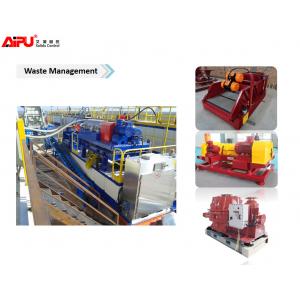Oil Base Solids Control System Mud Drilling Waste Management Equipment For Site
Add to Cart

Drilling Waste Management brief
All wells are drilled with generation of waste. Including drilling
cuttings, waste water, spent drilling fluids, completion fluids,
and filtration wastes and so on. With increasing legislation,
public awareness and minimum operator environmental standards, the
drilling waste management has increased in importance and no ranks
in importance along side that of drilling fluids around the world.
Drilling waste management systems are packages of different
function for drilling waste management. Usually include high G
drying shaker, auger feeder or screw conveyor, skid mounted
cuttings dryer, and decanter centrifuge with telescopic skid,
drilling cuttings tank or mud skips.
We are not a one size fits all treatment provider. To deliver
totally customized waste management solutions, we leverage a broad
portfolio of modular to deploy unique configurations tailored to
your operating needs. From shakers to cuttings dryer, conveyance
systems to thermal processing units, we have the right products to
tackle any challenge, and the expertly trained personnel to
implement the ideal solution.
Main specification Aipu drilling mud solids control system
| Rig | 350-450HP | 550-650HP(ZJ20) | 750HP(ZJ30) | 1000HP(ZJ40) | 1500HP(ZJ50) | 1500HP(ZJ50) |
| Mud Flow(m³/h) | 90 | 120 | 180 | 240 | 240 | 300 |
| Shaker Qty | 1 | 1 | 2 | 2 | 2 | 3 |
| Mud Cleaner | 1 | 1 | 1 | 1 | 1 | 1 |
| Centrifuge | 0 | 0 | 1 | 1-2 | 2 | 2 |
| Separation Size | 20 micron | 7 micron | 7 micron | 2 micron | 2 micron | 2 micron |
| Mud Tank Qty | 2 | 3 | 3 | 5 | 6 | 7 |
| Mud Tank Size | Customized | |||||
| Pipeline Arrange | Customized | |||||
Why we take attention to drilling waste so seriously?
Contamination of drilling fluids with drilled cuttings is an
unavoidable consequence of successful drilling operations. If the
drilling fluid does not carry cuttings and cavings to the surface,
the rig either is not “making hole” or soon will be stuck in the
hole it is making. The drill cuttings that are separated from the
drilling fluid on the surface by the soldis control equipment and
some quantity of unrecoverable or economically unwanted drilling
fluid are a major source of drilling waste. Drilled and formation
solids that are sized smaller than can be removed by the solids
control equipment are often reported as drill solids. Some
quantitiy of drill solids will accumulate in the drilling fluid and
must be removed by the solids control equipment or reduced in
concentration by dilution. -source
The process of drilling waste management
As the drill bit grinds rocks into drill cuttings, which become
entrained in the mud flow and are carried to the surface. In order
to get back in the mud to the recirculating mud system and to make
the solids easier to handle, the solids must be separated from the
mud. The first step in removing the cuttings from the mud involves
circulating the mixture of mud and cuttings over vibrating screens
called drying shakers. The liquid mud passes through the screens
and is recirculated back to the mud tanks from which mud is
withdrawn for pumping downhole. The drill cuttings remain on top of
the shale shaker screens; the vibratory action of the shakers moves
the cuttings down the screen and off the end of the shakers to a
point where they can be collected and stored in a tank or pit for
further treatment or management. Often two series of drying shakers
are used. The original series (primary shakers) uses coarse screens
to eliminate only the larger cuttings.
The second series (secondary shakers) utilizes fine mesh screens to
remove much smaller particles. In general, divided drill cuttings
are coated with a large quantity of drilling mud roughly equal in
volume to the cuttings. Additional mechanical processing is often
used in the mud pit system to further remove as many subtle solids
as possible because these particles are inclined to interfere with
drilling performance.
This automated equipment usually is the property of one of three
types: 1) hydrocyclone-type desilters and desanders, 2) mud
cleaners (hydrocyclone discharging on a fine screened shaker), and
3) rotary bowl decanting centrifuges. Parted select solids are
associated with the larger drill cuttings removed from the drying
shakers. If the solids collected by the shale shakers are still
coated with so much mud that they are unsuitable for the next reuse
or disposal step or if the used mud is valuable enough to collect
as much of it as possible, the solids can be further treated with
drying shakers utilizing high gravitational separation, vertical or
horizontal rotary cuttings dryers, screw-type squeeze presses, or
centrifuges. Cuttings dryers recover additional mud and produce
dry, powdery cuttings.
All wells are drilled with generation of waste. Including drilling
cuttings, waste water, spent drilling fluids, completion fluids,
and filtration wastes and so on. With increasing legislation,
public awareness and minimum operator environmental standards, the
drilling waste management has increased in importance and no ranks
in importance along side that of drilling fluids around the world.
In short, whole waste management is 4R’s processing;
Recycle-Get the circulation loop;
Recover-Help valuable material property recovery;
Reduce-Cut down disposal and cost;
Reuse-Reuse all reusable things;

